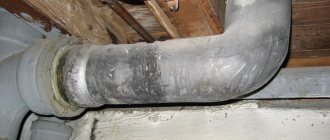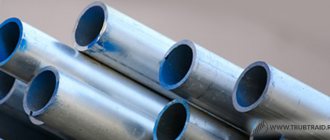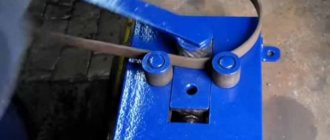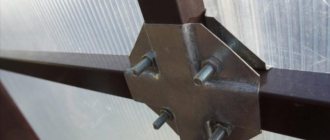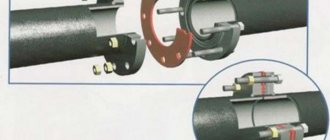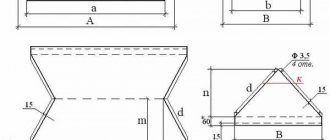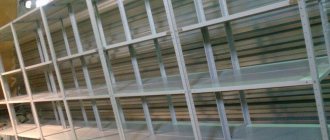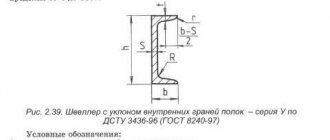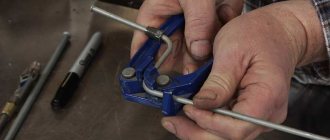When laying a sewer system or installing a water supply system, you should know how to connect a plastic pipe to a metal one. Let's look at such joint options as threadless and threaded, using welding, couplings or "crab". Let's look at their differences, where they are best used, what differences there are between materials, their properties and how they affect the type of connection. Let's take a look at the options for threaded fasteners and what benefits they provide.
Joint of metal and plastic pipes Source izhevsk.ru
Special types of pipe connections
In some cases, it is advisable to use fasteners with other types of fittings. Let's consider two options for such work.
Fastening using a special coupling
A fairly simple part can not only be purchased at building materials stores, but also made independently.
The device consists of the following parts:
- body made of cast iron or durable steel;
- two nuts, which are located on both sides of the part;
- rubber gaskets to seal the connection;
- four metal washers, which must be located in the internal cavity of the coupling.
The parameters of all elements must correspond to the diameter of the pipes on which they will be used.
Instructions for use: insert the ends of the pipes up to the middle of the coupling, threading them through the gaskets, washers and nuts, and then tighten the latter firmly so that they compress the gaskets.
Installation using a clamping coupling (Gebo fitting)
Joining metal and polymer pipes using threads guarantees a sealed seam, but this method is not always possible.
If the length of the metal pipe is short or it is adjacent to a horizontal surface, it is advisable to use a clamping coupling, which is also called a Hebo-type fitting (for example, HEBO-QUIK).
The clamping coupling (Gebo fitting) is especially recommended for installing dissimilar pipes located in difficult-to-reach places (for example, close to a wall)
Such a device consists of the following parts:
- housings;
- fastening nuts;
- clamping, pressure and sealing rings.
The work does not require special skills, special equipment or long time.
Procedure:
- Clean the edge of the metal pipe from dirt and old paint.
- Unscrew the coupling completely.
- Sequentially place all fastening parts onto the cast iron or steel element, with the O-ring located at a distance of 1 or more centimeters from the end of the product.
- Insert the end of the metal pipe into the coupling body, push all the existing rings towards it, and then tighten the bolt.
- An American fitting should be attached to the thread located on the other side of the coupling, having previously soldered a polymer pipe to it.
To check the strength of the fastener, you need to carefully pull the element, holding the pipe to which it is attached with your hand. The fitting must not move along the structure
If it reacts to your touch, you should tighten the thread tighter. Movement in this case will mean that you have chosen the wrong size, as a result of which the coupling does not sit tightly on the pipe
The fitting should not move on the structure. If it reacts to your touch, you should tighten the thread tighter. Movement in this case will mean that you have chosen the wrong size, as a result of which the coupling does not sit tightly on the pipe.
All types of fasteners described above can be used to connect metal pipes with metal-plastic elements.
Types of flanges
Established standards provide for many types of flanges. Most often, the types of flange connections are divided according to the following criteria:
- material;
- type of contact surface;
- design;
- protrusion height.
Connecting parts are made of gray and ductile cast iron, carbon, stainless, alloy steel, polypropylene.
The types of sealing surface are designated by Latin letters and are distinguished as follows:
- A – plane;
- B – connecting protrusion;
- F – depression;
- E – protrusion;
- D, M – groove;
- C, L – spike;
- K – under the lens gasket;
- J – for a gasket with an oval cross-section.
Products with the “spike” and “protrusion” surface types are not widespread. They are made only upon special orders.
According to their design, flanged disks are divided into:
- flat;
- collar;
- loose on the welded ring;
- for vessels and apparatus;
- stubs.
The last ones to plug are the end holes of dead-end pipes or cut off sections of the pipeline to be repaired. In addition, they produce quadrangular connectors with four holes for fasteners.
The height of the projection determines the pressure at which the flange connection is guaranteed to operate without damage. To operate at pressures ranging from 1.03 to 2.07 MPa, a protrusion height of 1.6 mm is sufficient. If the maximum pressure is 2.76 - 20.68 MPa, then the protrusion height should be 6.4 mm.
The flanges are attached in the same way, regardless of the types of connectors.
Mechanical joining method without soldering: connection options
Soldering as a method of joining pipeline sections is more often used during installation supervision in production. In everyday life, the most popular technologies are express installation without welding.
The time-tested practice of joining without the use of special tools ensures high quality joints of plastic pipes without soldering using couplings.
The widely known method is based on the use of shaped parts. With their help, you can not only ensure the continuation of the water supply circuit, but also change its direction, distribute the working medium or block the flow.
Advantages of installation technology without heating:
Finished polypropylene products are cheaper to connect using this method than metal ones due to the low cost of fittings.
Connections of plastic pipes without soldering using couplingsSource stroy-podskazka.ru
The design of the fittings makes it possible to manually assemble a complete engineering system of drainage, water supply, and sewerage.
The size and technical capabilities of parts are determined by their configuration (shape, wall thickness, combination).
Connection using compression fittings
When choosing how to connect plastic pipes for water supply without soldering, many people often use the compression fitting method. With this connection method, the process of heating adjacent parts is eliminated. A special coupling, under mechanical action (crimping), reliably fixes the two ends of the tubes equipped with o-rings inside. After installing the adapter, the joints are lubricated with silicone sealant.
Switching from metal-plastic to polypropylene using fittings is an indispensable way to join pipes made of different materials.
The advantages of this method:
- a minimum set of tools is used for installation;
- Even a beginner can trust the pipeline connection;
An example of a lubricant used when installing polypropylene pipesSource construct.smazka.ru
a reliable connection is created at the installation site of the compression fitting;
This method, first of all, is good because it can be used when updating cast-iron water pipes with polypropylene analogues. This method is also in demand when assembling heating systems, including the installation of radiators.
Connection using adhesives
Among the docking options that make it possible to do without special equipment is the use of assembly adhesives.
The base composition of the adhesive is polyvinyl chloride mixed with a solvent. Manufacturers also add various additives and plasticizers to it to improve adhesion at joints.
Advantages of the method:
- joining products using an adhesive provides the assembled structure with the necessary characteristics of strength and tightness;
- upon completion of work, a reliable connection is formed at the installation site, invisible during visual inspection;
- No special skills are required for docking.
Fitting polypropylene pipes before gluingSource www.asvshop.com
How to install with glue
Before connecting polypropylene pipes, you need to prepare the necessary parts, tools and provide conditions for installation work.
The surfaces on which the adhesive composition will be applied should be treated with a degreaser. To apply the composition, a brush with bristles made from natural materials is suitable. It is also recommended to ensure the room temperature ranges from 5 to 35 degrees.
Considering that the pipeline parts will be joined with a minimum gap, a thin layer of glue will be sufficient. Holding the pipes until they set usually does not exceed 20-30 seconds. Upon completion of work, it is recommended to ventilate the room well, while drafts should be avoided.
Mounting choice: detachable vs permanent
To connect copper pipes into a single pipeline system, you can use several methods of joining them. Various plumbers use crimp and press fittings, welding or soldering. But before you start work yourself, you need to decide whether the pipeline should be permanent or detachable.
There are three installation technologies for connecting copper pipes:
- electric welding;
- soldering using a torch or electric soldering iron;
- pressing.
All these technologies can be used in the formation of both detachable and one-piece systems. Here it is more a matter of using a variety of fittings and adapters or refusing them.
If the pipeline system needs to be detachable, and also easier to repair and add new elements, then the connections must be made detachable.
Fittings are used for this:
- compression;
- threaded;
- self-fixing.
It is easier to make detachable connections yourself; you can even do without soldering. They do not require excessively high qualifications from the master.
However, such units require constant inspection and tightening of the nuts to prevent leaks. Changes in pressure and temperature in the system lead to weakening of the fasteners. And from time to time it is recommended to tighten them.
If access to copper pipes is planned to be tightly closed with finishing or concrete screed, then it is best to connect them into an integral structure by soldering or welding. This system is more reliable, durable and resistant to abrasions.
Carvings are prohibited on copper products. This metal is too soft in its structure. When installing a detachable pipeline, all threaded connections must be made using fittings. The latter can be connected to a copper pipe by pressing or soldering.
Before making connections, copper pipes are prepared in a special way:
Features of installation of threaded fittings
Thanks to various types of threaded fittings when installing a pipeline, the ability to perform the most complex bends and turns is achieved.
The most common method of connecting metal/plastic structures is an “American” fitting. Such an element, which has a coupling and thread at the ends, allows you to easily and quickly join dissimilar parts
The most popular device for joining polymer and metal elements is the “American” fitting, which is available in various sizes. A convenient device with a plastic coupling and metal thread is extremely easy to install and allows you to create a reliable sealed connection in a short time.
Step-by-step installation instructions
To connect a metal pipe with a polypropylene or other plastic pipe, you must:
Using a special soldering iron, weld the fitting sleeve to the end of the polymer pipe, then wait for the joint to cool. Bring the metal part to the other end of the “American” and then tighten the thread. To seal the joint, it is advisable to additionally wrap it along the thread with one or two layers of FUM tape, tow or flax fiber (additionally, it can be coated with silicone). The fitting must always be tightened by hand: the use of tools is undesirable and even dangerous
Special equipment does not make it possible to fully control the applied forces, which can lead to damage to the part. After completing the work, it is important to check the strength of the resulting fastening. To do this, just turn on the water and make sure there is no leakage
If moisture still filters through the joint, you can try tightening the bolt a little tighter. If water continues to flow, it is necessary to unscrew the thread again and carry out all the manipulations again.
The shape of the finished connection can be changed by softening the plastic part using a hair dryer and then making the bend required by the project.
Metal pipe connection without thread
There are situations when a plastic pipe needs to be connected to a metal counterpart that does not have a thread.
Threads can be applied to a pipe using a special tool - a thread extender. In specialized stores you can find both mechanical and electrical models of such devices.
A similar problem can be solved by a special tool called a “thread maker” or “thread cutter”, with which you can apply grooves to a part made of steel or cast iron.
There are two adaptation options:
- Electric, which includes several cutters designed for pipes of different diameters. Such models are comfortable and easy to use, but have a high cost.
- A manual thread spreader is much cheaper, but working with it requires more physical strength and certain skills.
You can read in detail about how to cut threads on pipes in our article.
When using thread cutters, you should follow a few simple rules:
The tool cannot be used if the pipe is located a short distance from the wall. The electric thread spreader heats up quickly, so you will need to rest periodically when processing multiple elements. When working with a hand tool, it is important to alternate movements, making half a turn forward and a quarter turn back, until you cut the thread to the desired length.
To thread a pipe, you must thoroughly clean the pipe, remove any existing paint if necessary, and grind off any metal threads. Then carve using an electric or carving tool.
Clean the cut grooves well and lubricate them with grease, oil or other lubricant, and then use them to connect to the fitting.
Types of fittings
All connecting fittings are divided into several types according to their functions:
- Straight - for direct connection of two pipes of the same diameter. Such fittings are called couplings; the body usually has the shape of a cylinder.
- Transitional – for direct connection of two pipes of different diameters. Adapters, or gearboxes, have a complex shape: two short cylinders of different sizes are connected by a truncated cone.
- Angled, or rotary, - for connecting identical pipes at an angle. Such fittings are called bends or angles; the bending angle of the body is from 15 to 90 degrees.
- Branching - for combining two or more streams or dividing one stream into several. Tee bodies have three pipes, the diameters of which may vary. Cross bodies consist of four or more pipes connected at right angles.
- Sealing – for blocking free pipes. These shaped elements, called plugs, represent a lid or plug.
Types of connections between metal pipes and plastic pipes
Today there are two ways to perform this procedure:
- Threaded connection. It is used when connecting tubular products whose diameter does not exceed 40 mm.
- Flange connection. It is optimal for large cross-sections of pipes, since tightening the threads in such cases will require considerable physical effort.
Features of threaded connections
To understand how a plastic pipe is connected to a metal pipe using threads, you should study the fittings that are used for these purposes. In essence, this part is an adapter. On the side to which the metal pipeline will be connected, the fitting has a thread. On the opposite side there is a smooth coupling to which a plastic pipe is soldered. Also on sale there are models with which you can connect dissimilar lines in larger quantities and fittings for making bends and turns.
The threaded coupling is selected depending on the type of plastic pipe - for soldering, with a crimp or compression connection
To connect a steel pipe to a polypropylene pipe, you have to perform the following sequence of actions:
- remove the coupling from the steel communication in the area where it is supposed to be connected to the plastic pipeline branch. You can also cut off a piece of an old pipe, apply grease or oil and use a thread cutter to make a new thread;
- go over the thread with a cloth, secure a layer of fum tape or tow on top, and cover the surface with silicone. Wind 1-2 turns onto the thread so that the edges of the seal follow their course;
- screw on the fitting. This operation should be performed with an adapter from a plastic pipe to a metal one without using a key. Otherwise, the product may crack. If a leak appears when you open the tap, tighten the adapter.
The convenience of the design of this part is that it simplifies the procedure for connecting metal pipes with polypropylene pipes at turns and bends. Interestingly, the shape of the fitting can be changed if necessary. Heat it with a construction hairdryer to a temperature of +140˚С and give this part the required configuration.
Flange connection
As mentioned above, metal and plastic pipes of large diameter are connected using a similar method. The final structure is collapsible. The technology for connecting a plastic pipe to a metal pipe without a thread is as simple as in the case of using a threaded adapter.
carefully and evenly cut the pipe at the intended connection; put a flange on it and install a rubber gasket
It will act as a seal; carefully slide the flange onto this sealing element; Carry out the same actions with the other pipe; Bolt both flanges together
One of the options for switching from metal to plastic is a flange connection, in which case a flange is first soldered to the polymer pipe
Advice. Tighten the bolts evenly, without moving parts or using excessive force.
Other methods of threadless connection of metal and plastic pipes
To implement this technology, in addition to flanges, the following devices are also used:
Special coupling. This part is sold in a building materials store. However, if you have certain skills, you can do it yourself. This adapter consists of the following components:
- housings. It is best to make it from high-strength steel or cast iron;
- two nuts. They are located on both sides of the coupling. If you are going to make such an adapter with your own hands, use bronze or brass to produce nuts;
- four metal washers. They are installed in the internal cavity of the coupling;
- rubber gaskets. They are used to seal the connection. It is impossible to indicate their exact number in advance.
The diameter of the gaskets, washers and nuts must correspond to the cross-section of the pipeline elements. Connect a metal pipe to a plastic pipe without a thread using such a coupling in the sequence described below:
- Insert the ends of the pipes through the nuts to the middle of the coupling. Also, thread the tubing through the gaskets and washers.
- Tighten the nuts until they stop. The gaskets should be compressed.
The connection is durable and quite strong.
Using a Gebo type fitting, the connection can be made quickly and effortlessly, the main thing is to choose the right diameter
Gebo fitting. This part consists of the following elements:
- housings;
- nuts;
- clamping rings;
- clamping rings;
- sealing rings.
The connection is very simple.
- Unscrew the coupling completely.
- Place all of the above elements on the ends of the pipes to be connected.
- Secure the joint with nuts.
Need for repairs
In some cases, it is necessary, as an emergency, to replace the damaged area with a plastic pipe, and to do this as quickly as possible.
Yes, and when installing a new plumbing system, you often have to connect to an existing utility network consisting of steel or cast iron pipes (read about installing an acrylic bathtub in this article).
Be it connecting to the central water main of a private house or inserting a plastic pipe into the sewer riser of a high-rise building.
The use of threaded connections in such cases is not always justified, and sometimes it is impossible, for example, when connecting a heating expansion tank (how to calculate the capacity is written here) with a cast iron pipe.
Required tools and accessories
- A plastic cuff that has a transition from the existing diameter to the desired one.
- Plumbing sealant.
- Cuff lubricant. You can use household liquid soap.
- A flat-head screwdriver, a hammer and some kind of lever. As the latter, you can use a piece of metal pipe or a wooden beam.
To decide how to dismantle a unit, for example, a shower stall in a small bathroom (see design), you need to know how the connection of cast iron pipes works. A heel must be inserted inside.
This is linen thread impregnated with an antiseptic.
Cement or sulfur-based mortar was used to ensure sealing.
If the joint is on cement, you need to carefully knock out all the cement from the joint by lightly tapping it with a hammer on a screwdriver.
Typically, the layer thickness is no more than 0.5-1 cm.
If the connection is made using sulfur, you will need a gas burner.
The simplest household one, based on a gas can or a blowtorch, will do.
If there is no burner on the farm, you can go another way.
The pipe is cut along the edge of the joint, and the solution is drilled out with a thin drill.
Then it is removed using a screwdriver or a small chisel. But this method is more labor-intensive, and it is better to purchase a gas burner.
The flame of the burner evenly heats the pipe and the visible part of the solution.
At the same time, a very unpleasant and persistent odor can be released from the siphon under the kitchen sink.
Therefore, it is imperative to ensure ventilation of the room, and it is necessary to work in a gas mask or coal respirator.
When heating, ensure uniform heating of the sulfur and the pipe itself.
If you direct the flame to one point for a long time, the pipe may crack due to the temperature difference.
In some places, sulfur begins to leak out, but this is not a necessary condition.
It is enough to soften it throughout the entire mass.
The softened sulfur is gradually picked out from the connection, while at the same time trying to rock the pipe being removed. If the tee is removed, it is convenient to turn it using a lever.
It is better to do this work together - one loosens the pipe or tee, the other pushes it to the side.
After removing the unnecessary section of the pipe, the socket must be thoroughly cleaned of cement and dirt residues.
From the outside, this can be done by lightly tapping with a hammer, and from the inside - using a screwdriver or thin chisel.
If the heel is very strongly stuck to the surface of the pipe, you can use a wire brush to remove any remaining residue.
Do not forget to immediately plug the pipe hole behind the socket with a rag or cellophane bag.
If this is not done, drains drained from above may come out.
And we need to not only clean the internal surface of the joint well, but also thoroughly dry it before applying the sealant.
Yes, and it is advisable to block the odors coming from the sewer.
A layer of sealant is applied to the cleaned and dry surface of the socket.
It is advisable to also apply a small layer on the outer surface of the cuff, in each of its grooves.
Then the cuff is inserted into the pipe, and with light blows of a hammer it is driven as deep as possible.
There is no need to use sealant inside the cuff. A layer of plumbing silicone grease or liquid soap is applied to its inner surface.
Do not use grease, lithol or machine oil for this. Under their influence, the rubber may decompose over time, and the cuff will become unusable.
Next, a new plastic pipe is inserted into the cuff. It happens that even when using lubricant, it fits into the cuff very tightly.
In this case, the opposite edge of the pipe can be lightly tapped with a hammer.
In this case, it is necessary to use a spacer made of a wooden plank or plywood so that it covers the entire width of the socket.
Methods for joining polypropylene pipes
The choice of joining method depends on what kind of connection we want to get - detachable or not. The decision may be influenced by the availability of special tools and work skills. Let's look at the most commonly used methods.
Threaded fittings
If you are wondering how to make a detachable connection for polypropylene pipes, use threaded fittings. Working with such fittings is considered the simplest and allows you to achieve good results.
Threaded fittings are a combination of metal and plastic. The plastic part is connected to the polypropylene by welding or soldering through a plastic coupling. The second end of the element is made of metal, it has a thread through which it is connected to another piece of pipe or plumbing equipment.
To work you will need:
- Required fittings.
- Gas key.
- Slip-on coupling and key for its installation.
- Sealant.
To prevent leaks at the connection points of threaded fittings, flax fiber and fum tape are wound onto the threads. Threaded fittings are installed when connecting plastic pipes to metal ones.
Diffusion welding
This type of butt welding is obtained by melting the material of the parts and diffuse mutual penetration of molecules. Suitable for joining diameters from 16 to 40 mm. Additionally, a coupling is used, which provides a layer of plastic to create a seam. For thick-walled pipes, diffuse butt welding is used.
Welding with electrical fittings
An electrofitting is a connector made of polypropylene, in its design it has a metal heater, the contacts of which are brought out.
After the fitting is put on the pipe, the metal contacts are attached to the apparatus, the element is heated, and through it the fitting.
Butt welding
Based on the occurrence of diffusion when polypropylene is heated. To operate, you will need a disk unit equipped with a centering device to ensure pipe alignment. Performed for welding sections with a diameter of more than 60 mm with a wall of 4 mm.
The technology of work includes operations:
- The pipe joints are simultaneously heated to the required temperature with a disk soldering iron.
- Press the ends of the pipes against each other, making sure that their axes coincide and there is no distortion.
- Leave until the material cools.
Each welding machine is equipped with instructions that contain tables indicating heating and cooling times for a certain wall thickness. Thick-walled pipes produce a reliable seam. Such pipelines can be buried in the ground or walled up in a wall.
Cold welding
It is carried out when the material melts from the chemical action of the glue. It is applied to the areas to be joined, pressed, and left for 10-15 minutes. After stabilizing the substance, we obtain a sealed joint. The connection strength is low. Used in cooling fluid supply lines and other low-impact connections.
Adhesive connection
Apply a thin layer of glue to the cleaned surface, press the parts tightly against each other, and wait for 10 seconds. The joint reaches its highest strength within 24 hours
It is important to choose the correct adhesive composition; it must be intended for polypropylene
Flange Applications
Flanges are used when joining pipes made of different materials, for example, polyethylene and polypropylene. For tightness, rubber gaskets are used.
How to bend a metal-plastic pipe correctly
Metal-plastic pipes are very flexible, so they are quite easy to bend. Various devices and small machines are used to bend metal-plastic materials. Below I will talk about the most common methods of bending polymer pipes.
Which method is better
Despite the flexibility of metal-plastic pipes, it is better to bend them not by hand, but with the help of devices. When bent, the tubes do not form kinks or cracks and retain their round shape. The best method is using a pipe bender. Among manual methods, the best results are obtained when using a spring.
Bending pipes by hand
It is difficult to bend polypropylene, HDPE and PVC pipes by hand - they are too rigid for this. Tubes with a diameter of up to 20 mm made of cross-linked polyethylene bend well. Bending is carried out in several stages, otherwise a crease will form on it at the bending point.
Spring
Spring conductors of different diameters are made from thick wire. For small diameters, you can use an external jig; for workpieces with a larger diameter, it is inserted inside the pipe. The center of the spring and the bend must coincide exactly. Using a spring, it is easy to bend cross-linked polyethylene blanks. It is advisable to preheat HDPE and PVC using a hair dryer.
Pipe bender
The best bending quality is obtained when using a pipe bender. The tool either shapes the workpiece between rollers or bends (pulls) the workpiece on a mandrel. The bending of the workpiece is smooth and without defects - crumpling, creases, cracks.
They also use a homemade pipe bender called a Volnova machine.
Using a hair dryer
Metal-plastic pipes based on polyvinyl chloride or polypropylene are quite rigid; the blanks must be heated before bending. Bending is performed using fillers - sand, salt, small metal objects (finely cut wire). The workpiece is filled with filler, the holes at the ends are tightly closed, clamped in a vice, the bend area is heated with a hairdryer and bent.
List of materials
First, let’s find in memory what specific types of pipes are used in the construction of water supply networks.
Dark steel. Now it has lost its former popularity due to the spread of polymer materials, but still holds its ground due to its great mechanical strength.
- Galvanized metal pipe. It compares favorably with dark steel due to its corrosion resistance.
- Corrugated stainless steel.
- Copper.
- Metal-plastic is a three-layer structure made of cross-linked aluminum and polyethylene, which provides mechanical strength.
- Polypropylene (without reinforcement; fiber reinforced; aluminum foil reinforced).
- Polyethylene, used only for cold water supply due to limited heat resistance.
How to connect water pipes in each specific case?
Features of flange mounting
With this option for fastening polymer and metal pipes, special detachable devices are used - flanges and clamps. They not only allow you to create a strong joint, but also provide access to the junction of the pipes (to do this, just unscrew the bolts).
The diagram presented shows the connection of a metal and plastic pipe using a clamp. Such fasteners can be used on large diameter pipeline sections
There are several options for such devices, among which the most common are:
Free clamps resting on a straight collar Such parts are designed for mounting light elements with a diameter of up to 30 cm, as well as for medium and heavy pipes, for which this figure does not exceed 15 centimeters. Loose clamps supported by a tapered collar will help create structures from pipes with a diameter of no more than 20 cm. Blade fasteners with a shaped flange and a steel protrusion are considered universal; they can be used for joints of different elements, but it is important to pay attention to the size. A straight collar with a tapered transition can significantly increase the strength of the connection. Regardless of the clamp model used, to create a connection you must adhere to the following work regulations:. Regardless of the clamp model used, to create a connection you must adhere to the following work schedule:
Regardless of the clamp model used, to create a connection you must adhere to the following work schedule:
Before starting the manipulation, it is important to select an element of the required type, the size of which would correspond to the diameter of the metal part of the pipeline. You should carefully inspect the selected part: there should be no sharp burrs on the part that could scratch and damage the rather fragile plastic parts. The location of the intended insertion is determined on the steel (metal) pipe, then it is carefully cut (the edges must be smooth). After this, a clamp is put on the metal part. To ensure a tight connection, a rubber gasket is added to it, which should not extend beyond the cut line by more than one centimeter. Next, you need to connect all the elements of the fastening unit, using bolts to fasten the clamp on the metal pipe with a similar element installed on the polymer part. The bolts must be tightened calmly and evenly, making a full turn of the thread and avoiding excessive application of force, so as not to damage the rather fragile detail
Tightening the bolts must be done calmly and evenly, making a full turn of the thread and avoiding excessive application of force, so as not to damage the rather fragile part.
Flange application and installation method
Installation of flange connections is carried out on pipelines whose diameter starts from 32 mm. Installation of steel pipelines used for wastewater or pumping air masses is carried out on oval flanges. On other, more critical systems, only round flange connections are used.
According to the installation method, all types of pipelines are divided into free and rigid. The first ones are mounted on threaded connections, and to increase their reliability, they are sealed with special materials (fum tape, tow, Loctite, etc.), and the edges are flared. Rigid connections are secured by welding.
Helpful advice
If you do not have access to welding or need to provide a small number of connections.
This is especially true when repairing and connecting to old risers, where the use of welding and threading may not be cost-effective and reduce reliability.
When connecting a plastic sewer pipe to a cast iron one, the most difficult stage of the work is dismantling.
Here you need to be as careful as possible and be patient. The rest of the work does not cause difficulties, and is performed using a rubber cuff of the required diameter.
Watch a video that clearly demonstrates how to connect pipes without welding or threading.
Quick tips for connection and operation
- When using various fittings , it is advisable not to save much, since most often they are inexpensive and have a short service life.
- Be responsible when applying sealant to threaded connections, because most leaks occur precisely because of poor-quality winding.
- When starting the system for the first time , be sure to check all connections for leaks.
- Pipes connected in different ways must be painted to avoid rusting.
- When installing a water supply network , install a filter that will avoid contamination of the entire system.
- on the mounted elements as possible, do not place heavy things.
When is such a connection needed?
The need for connections of this type arises in the following cases:
- connecting to an existing metal (most often cast iron) riser of a polymer liner from a sink, sink, bathtub, etc.;
- installation of steel reinforcement on the HDPE pipeline;
- connection to a system with a high operating temperature, which low-density polyethylene (HDPE) cannot withstand;
- connection to the metal outlet of a garden irrigation system from the house;
- a tie-in into the central highway, the wiring to which passes through an area with increased load. In this place, stronger metal segments are used, and polymer pipes go up to it.
Reasons for using dissimilar materials
Usually, when laying water supply, sewer or other systems, builders try to use the same material. However, in some cases it is impossible to do without combined structures. The most common reasons are the following.
Planned replacement and urgent repair work . Cast iron communications, which are equipped in houses built several decades ago, are gradually failing. Over time, metal elements corrode or become clogged, requiring routine or emergency replacement.
It is quite natural that in this case, old cast iron or steel pipes are replaced with polymer ones, which are less expensive and easier to install.
In old houses with long-established communications, modern polymer pipes are often connected to metal (usually cast iron) risers
Construction . The process of individual or public construction of houses is associated with the laying of heating mains, sewerage, and water supply lines. Often, the installation of various systems is carried out by different organizations, due to the uncoordinated work of which several types of pipes are supplied to the construction site - both metal and plastic.
Special cases . In some situations, combining dissimilar materials is an urgent need, for example:
- connecting the pipeline to technological equipment, the high temperature of which low-melting plastic products cannot withstand;
- laying the highway in areas subject to increased loads, for example, under busy roads or when leaving a garage. In this case, more durable metal elements are laid in difficult areas, and polymer elements in the rest.
As we see, the need to combine different types of pipes arises quite often.
Features of metal-plastic pipe products
Metal-plastic pipes have a complex structure and combine the advantages of metal and plastic. The product consists of five layers:
- The inner and outer layers are cross-linked or compacted polyethylene. An organic material that does not change its structure, physical properties and remains chemically passive at temperatures up to 95 degrees and internal pressure up to 10 atm.
- The inner layer is aluminum foil. This lightweight and flexible metal gives the metal-plastic pipe special strength, the “ability” to hold a curved shape, and prevents the penetration of atmospheric oxygen inside.
- Two layers of special glue that hold the metal and stitched polyethylene together.
Advantages of metal-plastic pipes
Unlike a steel pipeline, the result is:
- much cheaper;
- lighter in weight;
- do not burst in the cold, being filled with coolant;
- Corrosion resistant.
Unlike plastic pipes, metal-plastic:
- remain flexible, but retain the given configuration, which allows the use of fewer fasteners and fittings;
- able to withstand increased loads;
- do not require soldering during installation;
- have less linear expansion.
We recommend that you read: Choosing a machine for high-quality welding of polyethylene pipes
Possessing the reliability of a metal pipe, metal-plastic household communications have the service life of modern plastic.
Polypropylene pipes - advantages and disadvantages
Home wiring made from this type of pipe is a monolithic connection through which leakage is impossible. This is the main advantage of residential water supply. The connections are made using special thermal welding, which does not require special skills and knowledge - one example is enough. Besides:
- Polypropylene is recommended for laying drinking water pipes. The material, as a chemical raw material, is resistant to corrosion, does not release harmful components into the atmosphere or water, and is inert to temperature.
- Polypropylene is successfully used in heating systems. The constant temperature of the carrier reaches 95 C. A short-term increase to 110 C is allowed.
- The diameter of polypropylene pipes is designed for any communications - from 16 to 125 mm. Autonomous boiler houses, pumping stations, and well casing are installed with them.
- Polypropylene filled pipes can withstand pressure up to 20 atm. And the gap is up to 40 atm. This guarantees safety from leaks. The wiring also withstands mechanical shocks and shows resistance to temperature changes - water does not freeze longer in styrene pipes, the network can be located outside the house, and the pipes themselves will return to normal as the temperature changes.
- Price is an important factor for evaluation. For polypropylene it is lower than in the totality of all components for a home plumbing system.
Disadvantages of polypropylene pipes
There is only one - the inability to bend pipes. To install a plumbing system with a large number of connection and consumption points, a large number of fittings are required. This is not very beautiful, however, the problem is alleviated by gating the walls, where the pipes are placed. The process is long and expensive, but one-time only.
How to connect a plastic pipe with a metal one in a sewer
Above, we discussed the method of connecting pipes in water supply lines and heating networks under pressure. Unlike pressure communications, domestic sewerage operates in a non-pressure mode, that is, the pipeline joints are not subject to physical impact from the working fluid transported through it. Therefore, the main requirement for joints in a sewer pipeline is to ensure tightness.
Rice. 11 Examples of how to connect a plastic pipe to a metal pipe using cuffs
Sewerage is usually laid with pipes made of cast iron and PVC polyvinyl chloride; if it is necessary to connect them, the following options are used:
Connection via cuff. If a cast iron sewer has an expanding socket at the end, a PVC pipe is inserted into it, sealing the joint with a rubber cuff. Cast iron is joined in the same way with larger PVC pipes, simply inserting them into the latter and sealing the cracks with O-rings.
Clamps. You can connect a plastic sewer pipe to a cast iron pipe using overhead clamps of a suitable size, purchased from a retail chain, or made independently.
To make clamps with your own hands, cut out a sheet of rubber, wrap it around the junction of two pipes and clamp it with clamps cut from strips of tin using bolts and nuts. If you don’t have the time or desire, you can simply wrap the joint with wire, twisting its ends tightly.
Adapters. One of the methods for connecting a PVC pipe to a metal one is to use adapters in the form of corrugated pipes with cuffs. Also, for joining pipes of different sizes, plastic shaped products are produced with a transition from large to small diameters.
Connecting couplings. You can join two pipes made of cast iron and polyvinyl chloride using a transition coupling cut from a piece of tin or PVC pipe. It is placed on top in place of the joined elements, and the resulting cracks are foamed with polyurethane foam or filled with waterproof elastic gaskets.
Rice. 12 Interfacing cast iron and PVC pipes with adapters
The correct connection of a metal and plastic pipe is achieved only by using threads on the two parts. Threadless connection of metal and plastic pipes in domestic conditions by any means refers to semi-handicraft methods and does not provide the conditions for tightness and strength of connections required at high pressures in the pipeline.
Main mistakes when connecting polypropylene to metal-plastic
When joining different materials, it is not always possible to do everything well, especially for such different types of materials as polypropylene and metal. The most common mistakes are:
- Excessive forces during connection, as a result of which the internal cross-section narrows and the load on the joint increases;
- loose connection, which can lead to leaks and destruction of other joints as a result of pressure surges;
- absence of sealant, tow, silicone.
The need to connect MP and PP pipes may arise in different situations, for example, during an urgent repair of a heating system or plumbing. However, sometimes you need to do this in cramped conditions. Therefore, it is worth understanding the connection methods in advance.
Nuances of socket connection of parts
The socket method of connecting parts is very simple. The edge of one pipe has a larger diameter; it is this that forms the socket into which the end of the other element is inserted. To make the connection airtight, a special rubber ring seal is used that is inserted into the socket, or another sealant. Installing a pipeline with connections of this type is not particularly difficult and resembles assembling a construction set. There are different types of socket joints.
Option #1 - without O-ring
The method is very often used to connect sewer cast iron pipes. Parts are measured. The inserted element is laid on wooden blocks and sawed along the intended line. The end of the outer part of the part must be free of cracks or nicks and strictly perpendicular to the axis of the pipe. The prepared pipe is inserted into the socket. The gap inside it must be sealed. Oiled hemp or tarred flax is used as a sealant. The first layer is inserted into the pipe with a ring, so that the ends of the strands do not get inside the part. The seal is caulked using a hammer and screwdriver.
The remaining layers of material are laid in the same way until approximately two-thirds of the depth of the socket is filled. The last layer is laid with a sealant without impregnation, which may interfere with adhesion to the solution. The remaining distance to the end of the pipe is filled with cement mortar or silicone sealant, asbestos-cement mixture, bitumen mastic and similar compounds.
To seal the socket joint of pipes without a sealant, tarred flax or oiled hemp is used
Option #2 - with an O-ring
It is considered one of the main methods of connecting plastic pipes. In this case, the tightness is ensured by a rubber ring, which is clamped between the straight end of the pipe and the walls of the socket. The seal, which can be either with or without special plastic liners, allows you to partially compensate for possible misalignment of the axes of the connected parts. However, uneven deformation of the sealing band on the ring can cause leaks in the joint area. Therefore, the curvature of the axis should be no more than the thickness of the pipe wall per each linear meter of the pipeline.
When installing a socket connection with an o-ring, you need to ensure that the centers are aligned. Otherwise, the distortion of the pipe will provoke deformation of the seal and, as a result, insufficient sealing of the connection
Some manufacturers produce models of tees and elbows not at a straight line, but at an angle of 87°. Thus, a pipe laid on a slope enters the socket without distorting the ring. During installation, to prevent damage to the seal, a chamfer is made on the smooth end of the pipe and lubricated with soap, glycerin or silicone. Oils are prohibited. The socket connection with the sealing ring is performed as follows:
We check the presence of an o-ring in the socket and a chamfer on the smooth end of the pipe
We clean the parts from possible contamination and apply lubricant. We place the smooth edge of the structure until it stops in the socket and put a mark
Carefully remove the part from the socket, extending it no more than 11 mm, while focusing on the previously placed mark. The resulting gap will compensate for temperature changes in the pipe length
On average, one bell compensates for the elongation of a two-meter fragment of the pipeline.
If it is necessary to connect pipes made of different materials using this method, special adapter pipes are used.
Option #3 - socket method using welding
Contact socket welding is intended for plastic parts and is carried out using special equipment. During the joining process, a mechanical or manual welding machine is used, equipped with special devices for heating the elements. This is a mandrel designed to melt the inner surface of the part, and a sleeve that heats the outer part of the pipe.
Polypropylene pipes are connected by socket welding. For this procedure, a special welding machine is used, which heats the parts to the required temperature.
The connection process is quite simple. A sleeve-mandrel set is selected that corresponds to the diameter of the pipes being connected. The devices are installed on the device platform and heated. The parts are put on the equipment and heated to the required temperature. Once this has been achieved, the elements are quickly and carefully removed and connected with a precise movement until they stop. The connection is left motionless until the plastic cools and completely hardens.
PVC pipes
They are equipped with a special socket, which is very helpful in installation.
PVC pipes are usually connected using gluing.
Briefly, the installation of PVC pipes looks like this:
- The outer end of one pipe and the inner surface of the bell of the other are ground with sandpaper to give them roughness and, as a result, better adhesion.
- The treated edges are degreased with methylene chloride.
- Apply glue to the entire length of the calibrated end of the pipe and 2/3 of the length of the socket. The most commonly used glue is GIPC-127; it is applied by very quickly spreading it in an even layer over the surface with soft brushes three to four centimeters wide.
- On both elements to be connected, quickly insert the pipe into the coupling (socket) until it stops, then turn it a quarter turn. Degreasing, applying glue and joining the pipe should take no more than three minutes.
- The connected elements are pressed and held in this state for at least a minute. If everything is done correctly, when gluing, a thin squeezed bead of glue appears.
It will take several hours for complete and uniform gluing.
Advice! If an error is made during the installation process, the connection should be disassembled only in the first 5-10 seconds. After this, all surfaces must be cleaned immediately with a degreaser.
